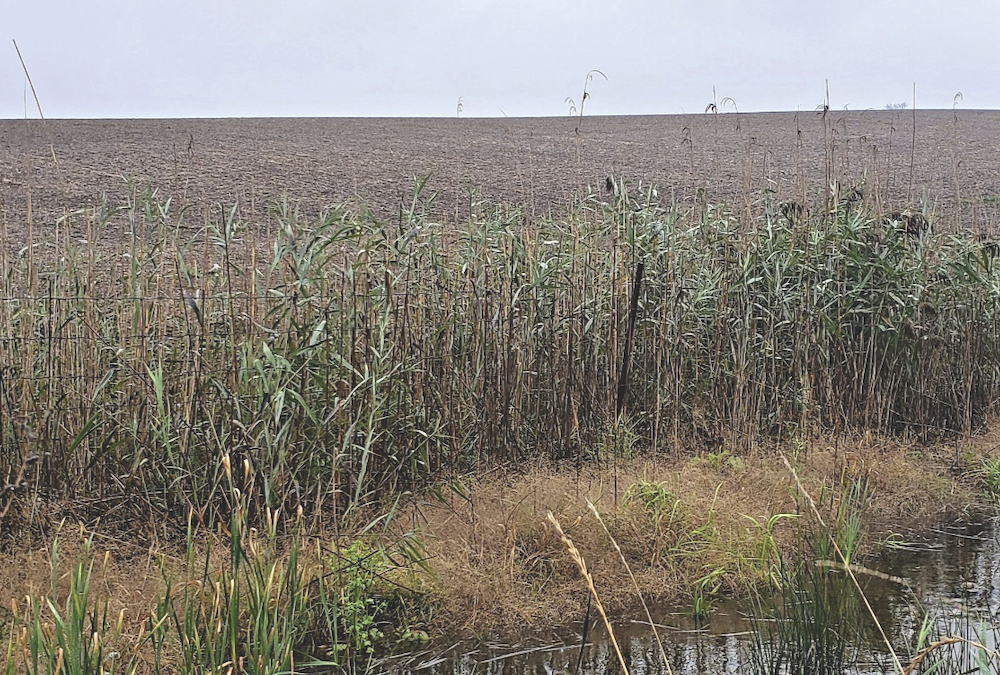You will have noticed these tall grasses swaying in the wind along roadsides, especially near ditches. They are likely phragmites, also known as common reed (Phragmites australis L.). It is a very widespread weed and one of the world’s most common plant species. In North America, there is a native type of phragmites that has achieved balance with its environment. However, races from Europe have been introduced and become invasive.
Traditionally, management of phragmites involves cutting of stems or even burning, but this has moderate success. These interventions set back stands, but they regrow. The problem is that phragmites is a perennial with an extensive rhizome network. For cutting or burning to be successful, they would have to be repeated multiple times.
As far as herbicides are concerned, only three active ingredients have phragmites on their label and can legally be used. Glyphosate is systemic, non-selective and non-residual. The label states application on phragmites must be done at rates between 2.0 to 8.0 L/ha (0.8 to 3.2 L/ac.). Imazapyr is another systemic, non-selective herbicide with soil residual activity. It is used for general weed control on non-crop sites and is sold as Arsenal Powerline and Habitat Aqua. The third active ingredient is sodium chloride (table salt) in the herbicide RagWeed Off. Sodium chloride acts as a contact herbicide and the label states two to four applications per year over multiple years should be done in order to attain desirable phragmites stand reduction.

We conducted two field trials to evaluate herbicide treatments that could extend the portfolio beyond standard treatments based on glyphosate and imazapyr. In 2019, we tested Garlon XRT (triclopyr) which is a commonly used product in vegetation management. While triclopyr provided early good results, it did not provide season-long control compared to glyphosate and the two formulations of imazapyr (Table 1 above). Interestingly, imazapyr did not show good control early in the season with 43 to 60 per cent visible injury at 30 days after treatment but it showed effectiveness in the long run. We also included two other herbicides with known activity against tough grasses. Assure II (quizalofop-p-ethyl) is a Group 1 herbicide used in a range of crops and is very effective at controlling annual grasses as well as rhizomatous perennials like quack grass. LongRun (flazasulfuron) is a vegetation-management Group 2 herbicide which is labelled for control of many grass species including hare barley, creeping bentgrass and tall fescue. Surprisingly neither of these products was able to provide acceptable control of phragmites. The reasons are unknown but could be due to a combination of the extensive network of thick rhizomes as well as the very dense canopy this weed produces. The 2020 trial confirmed that triclopyr provides suppression of phragmites (Table 2 below). As seen before, glyphosate was able to provide perfect control during the whole season.

Evaluation of biological control agents
Read Also

Sensing the soil: Root cell research finds ‘stress hormone’
Research into how root cells react to soil stressors could help plants better adapt to changes in their climate.
In collaboration with colleagues from Agriculture and Agri-Food Canada, the Ontario Ministry of Natural Resources, and the University of Toronto, we planned to evaluate the compatibility of bio-control insects specific to phragmites along with herbicides. However, the onset of the pandemic in 2020 forced us to re-adjust. Limited releases of Archanara sp. insects were done at a few sites and they are being monitored for winter survival. Hopefully, we will be able to expand the scope of the work in the near future.
This work was funded in part by the Ontario Ministry of Agriculture, Food and Rural Affairs through an agreement with Canada under the Canadian Agricultural Partnership.
Have a question you want answered? Hashtag #PestPatrol on Twitter to @cowbrough or email Mike at [email protected].
– Francois Tardif and Peter Smith are with the Department of Plant Agriculture, University of Guelph.















